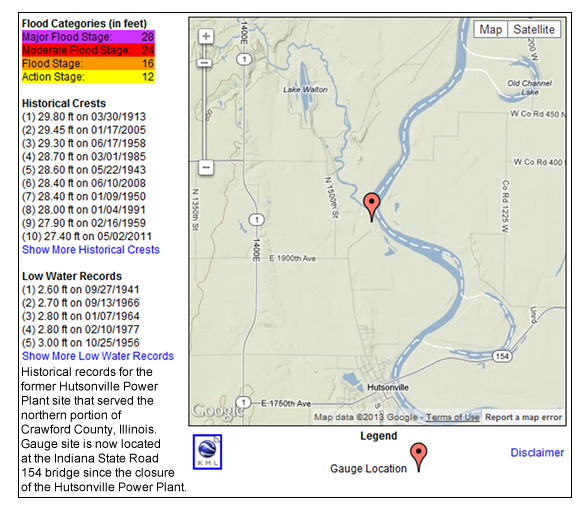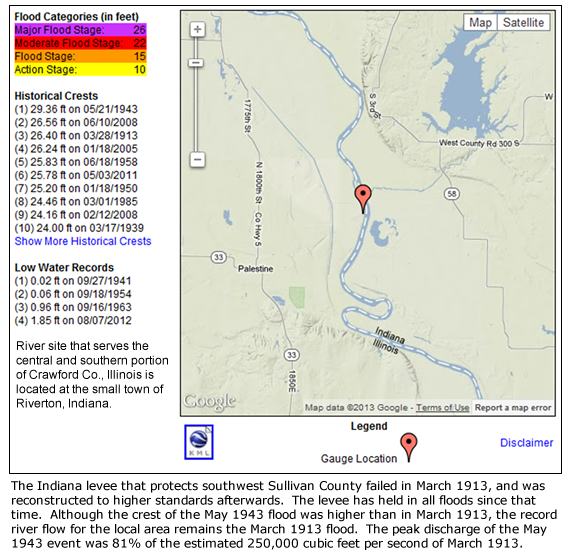The Great Flood of 1913
100 Years Later
Community Profiles: Crawford County, Illinois
| River: | Wabash |
| Storm Total Rainfall: | ~5-6" |
| Known Fatalities: | None |
Timeline
“The Great Flood of 1913”
by Rob Byrley
The month of March 1913 turned out to be quite a disastrous month for many of the eastern residents of Crawford County Illinois. Although the ever-expanding United States railway system was taking its toll on the dependency of the Wabash river for transporting grain and other goods, many residents still depended on the river for their livelihood and recreation which included fishing, transportation and water to support their farms. With the exception of the introduction of the Personal Income Tax act on March 1st, the month started out somewhat uneventful for the residents of Crawford County. Many were anticipating an early spring that would support a productive April mushroom season.
During March, much of the Heartland which included Ohio, Indiana and eastern Illinois was hampered with a series of heavy rains. Soon the once-friendly waters of the Wabash would become an enemy to many. On March 7th, the river stage was recorded at 8.1 feet just north of Palestine at Riverton, Indiana, which was followed with a steady rise for the next several days. During the last week of March, torrential rains arrived, which caused the mighty Wabash to break its highest recorded level at the time by 15 inches. On Friday the 28th, the river met its crest with a recorded level of 26.8 feet.

Impacts
The river villages of Hutsonville and Palestine suffered greatly. In Hutsonville, over twenty families were displaced as their homes were invaded by the unwelcome waters. The flood waters reached within yards of the rail tracks, the old tile factory was completely surrounded, and the Hutsonville hotel was nearly knee deep in water. Many of the lower streets and yards were now over three feet below the surface of the waters, and occasionally a curious carp could be seen swimming within the city limits. One eyewitness described that looking east from town gave the appearance of looking across a sea. The small levee south of Hutsonville that many county residents depended on was totally unprepared for such high waters, and didn’t stand a chance as it surrendered in several locations, resulting in extensive farmland flooding well before the river met its crest.
Five miles further south, the village of Palestine was suffering no less. Several families that lived in the eastern part of town had to now relocate, and the new part of the Palestine cemetery was mostly covered. Although the river didn’t quite reach the I.C. (Illinois Central) Railroad Wabash river bridge, the waters did manage to destroy over 600 feet of rail trestles and grade east of town. With the exception of the bridge near Miesenhelder’s Mill, every bridge entering Palestine was covered.
Later, Highway Commissioner Perry Brimberry would have to inform the township trustees that it would take over 50 loads of earth to repair the damage to the road grade leading north from town. Several low lying farms lost livestock from the deadly high waters, and much of the low tillable ground suffered from wash damage, which would take years to overcome. By April 4th, the flood was over and the river’s flood waters were slowly returning back to their banks, as flood waters eventually do, but memories of the “The Great Flood of 1913” would be handed down for generations to come.
Rob Byerly is a Crawford County historian and avocational archeologist, and Vice President of the Central Wabash Archeological Society.
Thanks also to Sue Jones, Crawford County Historical Society board member and researcher.
Sources: “The Hutsonville Herald” March & April 1913,
“The Robinson Argus” March & April 1913,
“The Palestine Pearl” March & April 1913,
“Events of 1913”.
Flood Protection Measures
Four Corps of Engineers reservoirs (JE Roush, Salamonie, Mississinewa and Cecil M. Harden) provide combined flood control benefits for about 17-18% of the drainage area upstream of Crawford County, Illinois. Local levees provide flood protection for some but not all floods.
To update information about the March 1913 flood in the Crawford County, Illinois area, please contact Al Shipe by e-mail at al.shipe@noaa.gov.

